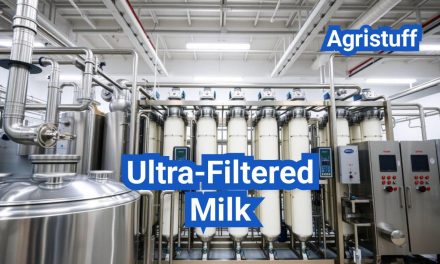Feta is a brined white cheese consider as soft cheese traditionally made from sheep’s milk or a mix of sheep’s and goat’s milk. Originating from ancient Greece, it features a crumbly yet slightly creamy texture with a tangy, salty flavor.
This iconic Mediterranean cheese has a rich history and diverse types, making it a staple in various cuisines. The article will explore the history, types, processing steps, equipment, and uses of Feta, providing a comprehensive overview of this beloved cheese.
Key Takeaways
- Understanding the history and origins of Feta
- Exploring the different types of Feta Cheese
- Learning about the processing steps involved in making Feta
- Discovering the equipment used in Feta production
- Examining the various uses of Feta in different cuisines
What Is Feta Cheese?
Feta is more than just a cheese; it’s a cultural icon in Greece. Known for its salty, tangy flavor and crumbly texture, feta has become a staple not only in Greek cuisine but also in kitchens around the world.
Definition and Basic Characteristics
Feta cheese is a type of brined cheese, characterized by its curing in a brine solution. This process gives feta its distinctive flavor and texture. Unlike other cheeses that are cooked or pressed, feta is cured briefly in the brine, which adds a salty flavor to the sharp tang of goat’s or sheep’s milk. The cheese is typically white, with a crumbly texture and a rich, tangy taste.
Feta is often associated with the Mediterranean diet, a dietary pattern known for its health benefits. The cheese is a good source of protein, calcium, and various vitamins and minerals, making it a nutritious addition to a balanced diet.
Origin and Cultural Significance
Feta cheese has a rich history that dates back centuries. Considered the national cheese of Greece, feta has been a staple in Greek cuisine for generations. Its production is deeply rooted in Greek culture, with traditional methods passed down through families. Feta is now made in many parts of the world, but its authenticity is protected by the PDO (Protected Designation of Origin) status granted to traditional Greek feta.
The cultural significance of feta extends beyond its culinary use. It is often served at social gatherings and is a key ingredient in many traditional Greek dishes, such as salads, pastries, and pasta. Feta’s presence in Greek cuisine is a testament to the country’s rich culinary heritage and its importance in bringing people together.
In summary, feta cheese is not just a food product; it’s a symbol of Greek culture and tradition. Its unique flavor and texture, combined with its rich history, make it a beloved cheese around the world.
The Rich History of Feta Cheese
With a history that stretches back millennia, Feta cheese remains one of Greece’s most prized culinary exports. The making, or so-called pickling, of Feta is an ancient practice that has been a cornerstone of Greek cuisine for centuries.
Ancient Origins in Greece
Feta’s origins are deeply rooted in ancient Greece, where shepherds first began making cheese from sheep’s and goat’s milk. The earliest recorded evidence of cheese-making in Greece dates back to the 8th century BC, with Homer’s Odyssey mentioning Polyphemus the Cyclops making sheep’s milk cheese, likely a precursor to modern Feta.
The process of making Feta was refined over time, with the cheese becoming an integral part of Greek cuisine and culture. Its production was initially a domestic activity, with families making it for their own consumption.
Evolution Through the Centuries
As Greek civilization evolved, so did the production and significance of Feta. During the Byzantine Empire, Feta became a staple in monasteries, where monks perfected its production techniques. The cheese was not only a food source but also a valuable commodity for trade.
By the 16th century, Feta had become a well-established product in Greece, with its production spreading across the country. The cheese was made in various regions, each developing its unique characteristics based on local milk types and production methods.
Modern Recognition and PDO Status
In recent years, Feta has gained international recognition, not just for its taste but also for its cultural significance. In 2002, the European Union granted Feta a Protected Designation of Origin (PDO) status, acknowledging its unique production methods and geographical origin.
This PDO status means that only cheese produced in specific areas of Greece, using traditional methods and primarily sheep’s milk (with up to 30% goat’s milk), can be labeled as “Feta.” This designation has helped protect the product’s authenticity and quality.
The key characteristics of PDO Feta include:
- Produced in specific regions of Greece
- Made primarily from sheep’s milk, with optional addition of goat’s milk
- Traditional production methods
- Distinctive taste and texture
Feta’s rich history, cultural significance, and protected status have cemented its place not only in Greek cuisine but also in the global culinary landscape.
Types of Feta Cheese

Feta cheese is not a single entity; it encompasses a range of types, each with its unique characteristics. The diversity in feta cheese is largely influenced by the type of milk used in its production, as well as the region and methods of production.
Traditional Greek PDO Feta
Traditional Greek PDO (Protected Designation of Origin) feta is considered the gold standard of feta cheese. It is made primarily from sheep’s milk, with up to 30% goat’s milk allowed. This type of feta is produced in specific regions of Greece and is known for its rich, tangy flavor and crumbly texture. The PDO status ensures that the cheese is produced according to traditional methods and within designated areas, maintaining its authenticity and quality.
Sheep’s Milk Feta
Sheep’s milk feta is the most traditional form of feta, offering a rich and creamy texture. The high fat content in sheep’s milk contributes to the cheese’s characteristic flavor and texture. Sheep’s milk feta is often considered superior due to its rich taste, which is both tangy and slightly sweet.
Goat’s Milk Feta
Goat’s milk feta, while less traditional than sheep’s milk feta, is gaining popularity for its lighter and slightly sweeter taste. Goat’s milk contains less fat than sheep’s milk, resulting in a slightly different texture and flavor profile. This type of feta is a good option for those looking for a milder version of the cheese.
Mixed Milk Varieties
Mixed milk feta combines sheep’s and goat’s milk, offering a balance between the rich flavor of sheep’s milk and the lighter taste of goat’s milk. The proportion of each type of milk can vary, allowing for a range of flavor profiles. Mixed milk feta is a versatile option, suitable for various culinary applications.
In conclusion, the different types of feta cheese cater to a wide range of tastes and culinary needs. Whether it’s the traditional Greek PDO feta, sheep’s milk feta, goat’s milk feta, or mixed milk varieties, each type brings its unique characteristics to the table.
Nutritional Profile of Feta Cheese
The nutritional profile of feta cheese reveals its value as a source of protein, calcium, and various vitamins. Feta cheese is a nutrient-rich food that can be part of a balanced diet when consumed in moderation.
Calories and Macronutrients
Feta cheese is relatively high in calories, primarily due to its fat content. A 1-ounce serving (28 grams) of feta typically contains around 75 calories, with approximately 6 grams of fat. The macronutrient breakdown shows that feta is a good source of protein, containing about 4 grams per ounce.
Nutritional Breakdown (per ounce of Feta Cheese):
| Nutrient | Amount |
|---|---|
| Calories | 75 |
| Fat | 6g |
| Protein | 4g |
| Calcium | 200mg |
| Sodium | 316mg |
Protein Content
Feta cheese is a good source of protein, making it a valuable component of meals for those looking to increase their protein intake. The protein in feta can help with muscle repair and maintenance.
Vitamins and Minerals
Feta is rich in various vitamins and minerals, including calcium, which is crucial for bone health, and vitamin B12, which is important for nerve function and the formation of red blood cells. Feta also contains other B vitamins, contributing to its nutritional value.
Sodium Content
One of the nutritional drawbacks of feta cheese is its high sodium content. With approximately 316 milligrams of sodium per ounce, feta can contribute significantly to daily sodium intake. Consumers, especially those with sodium-restricted diets, should be mindful of this when incorporating feta into their meals.
In conclusion, feta cheese offers a mix of nutritional benefits and considerations. Its high protein and calcium content make it a nutritious choice, while its sodium content requires moderation.
Health Benefits of Feta Cheese

With its rich nutritional profile, feta cheese contributes to various aspects of health. Feta cheese is not only a flavorful addition to many dishes, but it also offers several health benefits that make it a valuable part of a balanced diet.
Bone Health Support
Feta cheese is an excellent source of calcium, a mineral crucial for maintaining strong bones and teeth. Consuming feta cheese can help support bone health, potentially reducing the risk of osteoporosis and fractures. A diet rich in calcium, like that provided by feta cheese, is essential for bone health across all age groups.
Digestive Benefits
Feta cheese contains probiotics, which are beneficial bacteria that can aid in digestion and support gut health. These probiotics can help maintain a healthy gut microbiome, potentially improving digestive function and boosting the immune system. The presence of these beneficial bacteria in feta cheese makes it a nutritious choice for those looking to support their digestive health.
Beneficial Fatty Acids
Feta cheese is a source of various fatty acids, including conjugated linoleic acid (CLA), which has been associated with several health benefits. CLA is known for its potential anti-inflammatory properties and may contribute to improved heart health. The fatty acid profile of feta cheese makes it a healthier option compared to some other cheeses.
Role in Mediterranean Diet
Feta cheese is a key component of the Mediterranean diet, a dietary pattern that has been linked to numerous health benefits. The Mediterranean diet is characterized by high consumption of fruits, vegetables, whole grains, and healthy fats, with moderate consumption of dairy products like feta cheese. This dietary pattern has been associated with reduced risks of heart disease, type 2 diabetes, and certain cancers.
In summary, feta cheese offers several health benefits, from supporting bone health to being part of the nutritious Mediterranean diet. Its rich nutritional profile makes it a valuable addition to a balanced diet.
Potential Health Concerns
Feta cheese, while nutritious, poses several health concerns that consumers should be aware of. Its high sodium content, presence of lactose, and potential food safety issues are key areas of consideration for those who consume it regularly.
Sodium Considerations
Feta cheese is known for its high sodium content, which is a concern for individuals with high blood pressure or those on a low-sodium diet. The salting process involved in making Feta cheese contributes to its high sodium levels.
Sodium Content Comparison
| Cheese Type | Sodium Content (mg/oz) |
|---|---|
| Feta Cheese | 320-350 |
| Mozzarella Cheese | 150-200 |
| Parmesan Cheese | 400-450 |
Lactose Content
Feta cheese contains lactose, although the fermentation process reduces its lactose content compared to fresh milk. However, individuals with lactose intolerance may still experience discomfort after consuming Feta.
Lactose Content in Various Dairy Products
| Dairy Product | Lactose Content (g/100g) |
|---|---|
| Milk | 4.7-5.0 |
| Feta Cheese | 0.5-1.5 |
| Yogurt | 0.5-1.0 |
Food Safety Issues
Like any dairy product, Feta cheese can be susceptible to contamination if not handled properly. It’s crucial to store Feta cheese in its brine and keep it refrigerated to prevent bacterial growth.
Consumers should be aware of the expiration date and inspect the cheese for any visible signs of spoilage before consumption. Proper handling and storage can mitigate many of the food safety concerns associated with Feta cheese.
Feta Cheese Processing Steps

The production of Feta Cheese involves several crucial steps, starting from the selection of milk to the final salting and brining process. This traditional Greek cheese is crafted with precision and care, ensuring its distinctive flavor and texture.
Milk Selection and Preparation
The first step in making Feta Cheese is the selection and preparation of milk. Traditionally, Feta is made from sheep’s milk or a combination of sheep’s and goat’s milk. The quality of the milk is paramount, as it directly affects the flavor and quality of the final product. The milk is typically pasteurized to eliminate any harmful bacteria while preserving its natural characteristics.
Curdling Process
The curdling process is initiated by adding rennet, a group of enzymes, to the prepared milk. Rennet causes the milk to coagulate, separating it into solid curds and liquid whey. This process is critical in cheese production, as it determines the texture and consistency of the cheese. The curdling time can vary depending on factors such as temperature and the type of rennet used.
Cutting and Draining
Once the curds have formed, they are cut into small pieces to release more whey and create a smooth, even texture in the cheese. The curds are then left to rest for a short period, allowing the whey to separate further. The mixture is then transferred to a cheesecloth or a colander lined with cheesecloth, where the whey is drained off. This step is crucial for achieving the right consistency in the final product.
Salting and Brining
After draining, the curds are salted to enhance flavor and aid in preservation. The salted curds are then placed in a brine solution (usually a mixture of water and salt) where they mature. The brining process is essential for developing Feta’s characteristic tangy flavor and crumbly texture. The cheese is typically left in the brine for several weeks or months, during which time it develops its full flavor.
Feta Cheese processing involves a combination of traditional techniques and careful attention to detail. By understanding these steps, one can appreciate the craftsmanship that goes into creating this iconic cheese.
Equipment Needed for Feta Cheese Production

The equipment needed for Feta cheese production varies significantly across different production scales, including commercial, artisanal, and home cheesemaking. Understanding the specific requirements for each scale is crucial for producing high-quality Feta cheese.
Commercial Production Equipment
For commercial Feta cheese production, manufacturers require sophisticated equipment to handle large quantities of milk and to ensure consistency in the final product. Some of the key equipment includes:
- Milk Pasteurization Equipment: Pasteurizers are essential for killing harmful bacteria in the milk.
- Cheese Molds: These are used to shape the Feta cheese into its characteristic form.
- Brine Tanks: Large tanks are needed for aging the Feta cheese in brine, which is crucial for its flavor and texture.
- Cutting and Stirring Tools: Automated cutters and stirrers help in achieving uniform curd size and distribution.
Artisanal Production Tools
Artisanal Feta cheese production, while smaller in scale, still requires specific tools to maintain the quality and authenticity of the cheese. Artisanal producers often use:
- Traditional Cheese Molds: Often made from materials like wood or metal, these molds give the cheese its traditional look.
- Handheld Cutting Tools: Artisanal producers use manual or handheld tools for cutting the curd.
- Wooden or Plastic Containers: For aging the cheese, artisanal producers often use containers that allow for proper airflow and brine circulation.
Home Cheesemaking Equipment
For those making Feta cheese at home, the equipment needed is more basic and accessible. Home cheesemakers typically require:
- Large Pots: For heating the milk and curdling process.
- Cheesecloth or Butter Muslin: For draining the whey from the curds.
- A Colander or Strainers: To separate the curds from the whey.
- Containers for Brining: A clean, food-grade container is necessary for aging the Feta in brine.
By understanding the equipment needs for Feta cheese production at different scales, producers can better plan their operations and ensure the production of high-quality cheese.
How to Make Feta Cheese at Home

With just a handful of ingredients and some patience, you can create delicious feta cheese in the comfort of your own kitchen. Making feta at home allows you to control the ingredients, texture, and flavor, ensuring a product that suits your taste preferences.
Ingredients Needed
To start, you’ll need a few simple ingredients:
- 1 gallon of sheep’s milk or a combination of sheep’s and goat’s milk
- 1/4 tsp (1.25 ml) mesophilic cheese culture
- 1/4 tsp (1.25 ml) lipase powder (optional, for a stronger flavor)
- 1/4 tsp (1.25 ml) liquid rennet
- 1 tsp (5 ml) cheese salt
- Brine solution (see below for recipe)
For the brine solution, you’ll need:
- 1 cup (250 ml) water
- 1/2 cup (125 ml) cheese salt
Step-by-Step Process
Making feta cheese involves several key steps:
- Milk Preparation: Begin by heating the milk to 86°F (30°C). Add the mesophilic cheese culture and lipase powder (if using), and gently stir to distribute. Allow the mixture to ripen for 45 minutes.
- Curdling: Add the liquid rennet and stir gently for about 30 seconds to ensure it’s fully incorporated. Allow the milk to coagulate for 30-45 minutes, or until it has set firmly.
- Curd Cutting and Draining: Cut the curds into 1/2-inch (1 cm) pieces and let them rest for 10 minutes. Then, gently stir the curds for another 20-30 minutes. Line a colander with cheesecloth and place it over a large pot or bowl. Carefully pour the curds into the cheesecloth, allowing the whey to drain off.
- Salting and Brining: Once the curds have drained sufficiently, transfer them to a mold or form. Sprinkle cheese salt over the curds, then let them sit at room temperature for a few hours. Afterward, cut the cheese into blocks or crumble it, and submerge it in the prepared brine solution.
- The cheese should be stored in the refrigerator, submerged in its brine, where it will keep for several months.
Troubleshooting Common Issues
- Even with careful preparation, issues can arise during the cheesemaking process. Here are some common problems and their solutions:
| Issue | Cause | Solution |
|---|---|---|
| Soft or crumbly texture | Insufficient draining or incorrect temperature | Adjust draining time or temperature control |
| Too salty | Excessive salt used in brining | Reduce salt in brine or rinse cheese before serving |
| Mold growth on surface | Inadequate brine coverage | Ensure cheese is fully submerged in brine |
- By following these steps and being mindful of potential issues, you can successfully make feta cheese at home, enjoying a delicious and rewarding homemade product.
Feta Cheese Comparisons

Feta cheese stands out among other cheeses, but how does it compare to the likes of goat cheese and Cotija? Understanding these comparisons can help you make informed decisions in your culinary endeavors.
Feta vs. Goat Cheese
Feta and goat cheese share some similarities, but they are distinct in terms of taste and texture. Feta is typically made from sheep’s milk or a combination of sheep and goat’s milk, giving it a tangier flavor. Goat cheese, on the other hand, is made from goat’s milk and tends to be creamier.
- Taste: Feta is tangier and saltier, while goat cheese is generally milder.
- Texture: Feta is crumbly, whereas goat cheese can range from creamy to crumbly depending on its age.
Feta vs. Cotija
Cotija cheese, originating from Mexico, is often compared to Feta due to its similar texture and salty flavor. However, Cotija is typically made from cow’s milk, giving it a different taste profile.
- Milk Source: Feta is usually made from sheep’s or a mix of sheep and goat’s milk, while Cotija is made from cow’s milk.
- Flavor: Both are salty, but Cotija has a more pronounced, aged flavor.
Feta vs. Other Brined Cheeses
Feta is a type of brined cheese, characterized by its storage in brine. Other brined cheeses include Bulgarian sirene and Turkish beyaz peynir.
- Similarities: All are stored in brine, giving them a salty flavor and a longer shelf life.
- Differences: The milk source and production methods vary, affecting their taste and texture.
Substitutes for Feta
If you’re looking for substitutes for Feta, several cheeses can fill in, depending on the recipe. Goat cheese, ricotta salata, and even cottage cheese can be used in certain dishes.
“While Feta is unique, its substitutes can offer similar textures and flavors in recipes.”
- Goat Cheese: A good substitute in salads and spreads.
- Ricotta Salata: Offers a similar texture and can be used in pasta dishes.
- Cottage Cheese: Can be used in recipes where a softer cheese is acceptable.
Feta Cheese in the United States
In recent years, the United States has seen a significant increase in the consumption of feta cheese, reflecting its growing culinary appeal. This rise in popularity has led to a diverse market featuring both domestic production and imported options.
Market Presence and Popularity
Feta cheese has become a staple in many American kitchens, used in a variety of dishes from salads to pastas. Its tangy flavor and crumbly texture have made it a favorite among chefs and home cooks alike. The growing demand for feta has been driven by its versatility and the increasing popularity of Mediterranean cuisine.
The market presence of feta cheese is evident in its widespread availability in supermarkets and specialty stores across the U.S. It is often featured in gourmet sections or international food aisles, highlighting its status as a premium product.
American-Made Feta
Domestic production of feta cheese has seen significant growth, with many American dairy farms and creameries producing high-quality feta. American-made feta often uses a combination of sheep’s and goat’s milk, adhering to traditional methods while incorporating local flavors.
Some notable American creameries have gained recognition for their feta products, offering consumers a taste of locally produced, artisanal feta that rivals imported varieties.
Imported Options
Despite the growth of domestic production, imported feta from countries like Greece remains highly sought after. Traditional Greek feta, made from sheep’s milk or a combination of sheep’s and goat’s milk, is protected by a Protected Designation of Origin (PDO) status, ensuring its authenticity and quality.
Imported feta is often preferred for its distinctive flavor profile, which is shaped by the specific breeds of sheep and goats used, as well as the regional production methods.
Best Brands to Try
For consumers looking to explore the world of feta cheese, there are several best brands to consider. Some top recommendations include:
- Kalamata Feta by Dodoni
- Greek Feta by Mt. Vikos
- Crooked Creek Creamery’s American Feta
- Shepherd’s Feta by Rogue Creamery
These brands offer a range of flavors and textures, from traditional Greek-style feta to innovative American interpretations. Exploring these options can help consumers find their preferred feta for various culinary applications.
Culinary Uses of Feta Cheese

Feta cheese, known for its salty, tangy flavor, is a key component in numerous Greek recipes and beyond. Its versatility makes it a favorite among chefs and home cooks alike.
Traditional Greek Applications
In traditional Greek cuisine, feta is often used in dishes that highlight its rich flavor. One of the most iconic uses is in the classic Greek salad, where feta is combined with tomatoes, cucumbers, and olives. It’s also a crucial ingredient in spanakopita, a spinach and feta pie that’s both savory and satisfying.
Feta is also used as a topping for various Greek dishes, adding a burst of flavor to otherwise simple meals. Its crumbly texture makes it easy to sprinkle over salads, pasta, or as a garnish for soups.
Salad Preparations
Feta cheese is a staple in many salad recipes, not just the traditional Greek salad. It pairs well with watermelon, making for a refreshing summer salad. The saltiness of feta complements the sweetness of watermelon, creating a delightful contrast of flavors.
In other salad preparations, feta can be crumbled over mixed greens, added to pasta salads, or used in quinoa bowls. Its tangy flavor enhances the overall taste, making salads more engaging and flavorful.
Pasta Dishes
Feta has become a popular ingredient in pasta dishes, particularly in recipes that have gone viral on social media. Baked feta pasta, for instance, combines feta with cherry tomatoes, garlic, and pasta, creating a creamy, savory sauce. This dish is not only delicious but also easy to prepare, making it a favorite among home cooks.
In more traditional pasta dishes, feta can be sprinkled over Greek-inspired pasta recipes, adding a salty, tangy flavor that complements the other ingredients.
Baking with Feta
Feta is also used in baking, particularly in savory pastries and pies. Spanakopita, mentioned earlier, is a prime example. Feta can also be used in tyropita, a cheese pie that’s rich and flavorful. When baking with feta, it’s often combined with other ingredients like spinach, herbs, or sun-dried tomatoes to enhance its flavor.
The versatility of feta in baking makes it a valuable ingredient for creating both sweet and savory dishes, though it’s more commonly associated with the latter.
Popular Feta Cheese Recipes

From traditional Greek dishes to modern fusion cuisine, Feta cheese plays a starring role. Its tangy flavor and crumbly texture make it a favorite among chefs and home cooks alike. Here are some popular Feta cheese recipes that you can try at home.
Classic Greek Salad
The classic Greek salad is a staple in Greek cuisine, and for good reason. It’s simple, refreshing, and showcases the beauty of Feta cheese.
- 4 cups mixed greens
- 1 cup cherry tomatoes, halved
- 1 cup cucumber, sliced
- 1/2 cup red onion, thinly sliced
- 1/2 cup Kalamata olives
- 1/2 cup crumbled Feta cheese
- 2 tbsp olive oil
- 1 tbsp red wine vinegar
Combine all the ingredients in a large bowl and toss gently. Drizzle with olive oil and red wine vinegar, and serve immediately.
Viral TikTok Baked Feta Pasta
This recipe became a sensation on TikTok, and it’s easy to see why. The combination of baked Feta cheese, cherry tomatoes, and pasta is a match made in heaven.
- Preheat oven to 400°F (200°C).
- Place a block of Feta cheese in a baking dish, surrounded by cherry tomatoes.
- Drizzle with olive oil and season with salt, pepper, and dried basil.
- Bake for 15-20 minutes, or until the Feta is soft and the tomatoes are bursting.
- Cook pasta according to package instructions, then toss with the baked Feta and tomatoes.
Spanakopita (Greek Spinach Pie)
Spanakopita is a traditional Greek spinach pie that’s perfect for brunch or as a snack. It’s made with layers of flaky phyllo dough, spinach, and Feta cheese.
| Ingredients | Quantity |
|---|---|
| 1 package phyllo dough | 1 |
| 2 cups fresh spinach, chopped | 2 |
| 1 cup crumbled Feta cheese | 1 |
| 1/2 cup grated Parmesan cheese | 0.5 |
| 1/4 cup olive oil | 0.25 |
Layer the phyllo dough, spinach, and Feta cheese in a baking dish, finishing with a layer of phyllo on top. Drizzle with olive oil and bake until golden brown.
Watermelon Feta Salad
This refreshing salad is perfect for summer. The sweetness of the watermelon pairs beautifully with the tanginess of the Feta cheese.
“The combination of watermelon and Feta cheese is a revelation. It’s a simple yet elegant salad that’s sure to impress your guests.” –
A renowned food critic
- 4 cups diced watermelon
- 1/2 cup crumbled Feta cheese
- 1/4 cup chopped fresh mint
- 2 tbsp olive oil
- 1 tbsp balsamic glaze
Combine the watermelon, Feta cheese, and mint in a bowl. Drizzle with olive oil and balsamic glaze, and serve chilled.
How to Store Feta Cheese Properly
To keep Feta cheese fresh for a longer period, it’s essential to store it correctly. Feta cheese is typically stored in brine, which helps maintain its moisture and flavor. However, there are other storage methods, including dry storage and freezing, each with its own advantages.
Brine Storage Method
Storing Feta in brine is the most recommended method as it preserves the cheese’s original texture and taste. The brine acts as a barrier, preventing the cheese from drying out and absorbing unwanted flavors from other foods.
To store Feta in brine, submerge the cheese completely in a salty solution (about 6-8% salt concentration) in an airtight container. This method is effective for both short-term and long-term storage.
Homemade Feta Brine Recipe
Preparing a homemade brine is simple. You’ll need water, salt, and optionally, some flavorings like garlic or herbs. Here’s a basic recipe:
- 1 liter of water
- 60-80 grams of salt
- Optional: garlic cloves, black peppercorns, or fresh herbs like thyme or dill
Combine the water and salt in a saucepan, heating it until the salt dissolves. Let it cool, then add your chosen flavorings. Store the brine in the refrigerator.
Dry Storage Options
If you don’t have brine or prefer not to use it, you can store Feta cheese in an airtight container in the refrigerator. Wrap the cheese tightly in plastic wrap or aluminum foil to prevent drying.
While dry storage is convenient, it may cause the cheese to lose some of its moisture and flavor over time.
Freezing Possibilities
Freezing is another storage option, although it may affect the texture of the Feta. To freeze, wrap the cheese tightly and place it in an airtight container or freezer bag. Frozen Feta is best used in cooked dishes where texture isn’t a primary concern.
| Storage Method | Advantages | Disadvantages |
|---|---|---|
| Brine Storage | Preserves moisture and flavor | Requires preparation of brine |
| Dry Storage | Convenient, no brine needed | May cause drying out |
| Freezing | Long-term storage | May alter texture |
By choosing the right storage method, you can enjoy your Feta cheese for a longer period while maintaining its quality.
At The End of: Feta Cheese
Feta cheese is a unique and flavorful cheese with a rich history and cultural significance. Throughout this article, we have explored its origins, types, nutritional profile, and various uses in cuisine. From traditional Greek applications to modern recipes, Feta Cheese has proven to be a versatile ingredient.
The journey of Feta Cheese, from its ancient origins in Greece to its modern recognition and PDO status, highlights its importance in culinary and cultural contexts. Whether used in salads, pasta dishes, or as a topping, Feta Cheese adds a distinctive flavor and texture.
In summary, Feta Cheese is more than just a type of cheese; it is a connection to Greek heritage and a staple in Mediterranean cuisine. Its diverse applications and rich flavor profile make it a beloved ingredient worldwide. As we conclude our exploration of Feta Cheese, it is clear that its significance extends beyond the kitchen, representing a rich culinary legacy.
FAQ
What is Feta Cheese?
Feta cheese is a type of brined white cheese originating from Greece, typically made from sheep’s milk or a combination of sheep’s and goat’s milk.
What are the different types of Feta Cheese?
The main types of Feta cheese include traditional Greek PDO Feta, sheep’s milk Feta, goat’s milk Feta, and mixed milk varieties, each with its unique flavor profile and texture.
Is Feta Cheese healthy?
Feta cheese can be part of a healthy diet due to its high protein content, beneficial fatty acids, and support for bone health, but it is also high in sodium and calories, so moderation is key.
How is Feta Cheese made?
Feta cheese is made through a process involving milk selection and preparation, curdling, cutting and draining, salting, and brining, which gives it its characteristic taste and texture.
Can I make Feta Cheese at home?
Yes, you can make Feta cheese at home with the right ingredients and equipment, following a step-by-step process that includes curdling, draining, and brining the cheese.
How do I store Feta Cheese properly?
To store Feta cheese properly, keep it in its brine, or make a homemade brine if the original is not available, and store it in the refrigerator to maintain its freshness and quality.
What are some popular recipes using Feta Cheese?
Popular recipes using Feta cheese include the classic Greek salad, baked Feta pasta, spanakopita (Greek spinach pie), and watermelon Feta salad, showcasing its versatility in various dishes.
Can I freeze Feta Cheese?
While it’s possible to freeze Feta cheese, it’s not recommended as it can affect its texture and flavor; however, if you must freeze it, do so in an airtight container or freezer bag.
What are some substitutes for Feta Cheese?
Substitutes for Feta cheese include other brined cheeses like goat cheese or Cotija, though they may not have the exact same taste or texture, they can be used in similar recipes.
Is Feta Cheese suitable for vegetarians?
Feta cheese can be suitable for vegetarians, but it’s essential to check the production process and ingredients, as some Feta may use animal rennet, while others use microbial rennet.
What is the nutritional profile of Feta Cheese?
Feta cheese is relatively high in calories, protein, and sodium, and a good source of various vitamins and minerals, including calcium, phosphorus, and vitamin B12.
Conclusion of Feta Cheese: History, Types, Processing Steps, Equipment And Uses
Feta Cheese: a quick definition that matters for U.S. readers
Feta Cheese is a brined, crumbly white cheese with a tangy, salty finish, traditionally made from sheep’s milk or a mix of sheep and goat milk. For authenticity, Feta Cheese in the European Union is protected as a PDO (Protected Designation of Origin), reserved for specific Greek regions and practices, while in the U.S. you’ll also find domestic feta-style products. Knowing these distinctions helps American shoppers choose Feta Cheese that fits their flavor expectations and culinary goals. European Commission – Feta PDO overview
Feta Cheese history: from ancient storytelling to modern PDO
Across the Mediterranean, Feta Cheese has been part of daily life for centuries, with feta-like cheese referenced in classical literature and the term “feta” appearing in the 17th century to describe sliced, brined blocks. That long arc of tradition explains why Feta Cheese is closely tied to Greece’s landscape, flocks, and craftsmanship—elements that today’s PDO preserves. For U.S. readers, this history explains why imported Feta Cheese can taste distinct from generic “feta” labels. EU background on Feta PDO
Feta Cheese and PDO rules: milk, place, time
Under PDO rules, authentic Feta Cheese must be produced in defined Greek regions using ewe’s milk or a blend of ewe’s milk with up to 30% goat’s milk, then ripened in brine for at least two months. The specification bans additives like colorants and milk powders and prohibits pressing during draining, helping Feta Cheese keep its crumbly body and bright, lemony salinity. U.S. shoppers can look for the PDO seal to identify genuine Greek Feta Cheese. EUR-Lex – PDO registration for “Feta”
Feta Cheese and the 2005 court decision that cemented protection
When some EU countries argued that “feta” was generic, the Court of Justice of the European Union upheld the PDO for Feta Cheese in 2005. The court found that the cheese’s characteristics were linked to Greek geography, breeds, and techniques. For Americans importing or buying EU-labeled products, the ruling explains why only Greek producers can sell Feta Cheese under that name within the EU. CJEU judgment (C-465/02 & C-466/02)
Feta Cheese in the United States: labeling differences
In the U.S., the term Feta Cheese isn’t legally limited to Greece, so domestic makers may produce feta-style cheeses from cow, goat, or sheep milk if they meet safety and labeling rules. Because there is no specific federal “standard of identity” for Feta Cheese, reading labels is essential: look for milk type, country of origin, and ingredients that align with your flavor goals. This helps American buyers distinguish Greek PDO Feta Cheese from domestic variations. Penn State Extension – U.S. cheese labeling vs global standards
Milk and starter culture: what gives Feta Cheese its signature tang
Flavor in Feta Cheese starts with the milk: ewe’s milk brings rich, savory depth; goat’s milk adds a peppery brightness and keeps the paste gleaming white. Cheesemakers inoculate with mesophilic cultures (often Lactococcus spp.) to acidify, then add rennet to coagulate. These choices shape curd structure, brine uptake, and the fresh, tangy profile people expect from Feta Cheese in salads, pastries, and dips. University of Guelph – Feta cheesemaking basics
Processing steps for Feta Cheese: the make schedule
In a typical make, milk for Feta Cheese is pasteurized (e.g., 72 °C for 16 s or 62.5 °C for 30 min), cultured, and set with rennet at ~30–31 °C. The curd is cut small, gently stirred, ladled into perforated molds to drain without pressing, then salted. Blocks of Feta Cheese move to brine—often ~8% NaCl with calcium and pH adjustments—for ripening. Controlled acidification (to ~pH 4.6 in 24 h) produces the clean crumble and bright salinity associated with quality Feta Cheese. University of Guelph – Step-by-step Feta procedure
Brining and ripening: why Feta Cheese stays fresh, firm, and flavorful
Brine is central to Feta Cheese. A common approach is brining at ~8% salt with calcium chloride around pH ~4.6, ripening near 8–10 °C for several weeks, and then cold storage. Brine composition and temperature drive salt uptake, texture, and microbial stability, while ripening time tunes the tang and crumbly body of mature Feta Cheese. These parameters underpin the consistency you taste in good retail and foodservice products. University of Guelph – Brine, ripening & storage
Nutrition profile: what 100 grams of Feta Cheese delivers
Typical nutrition for Feta Cheese (per ~100 g) is roughly 265–280 kcal, ~21 g fat, ~14 g protein, and ~900–1100 mg sodium, though brands vary with moisture and brine. The elevated sodium preserves Feta Cheese and gives concentrated savory impact—useful for salads and bowls where small amounts go a long way. For precise label data and comparisons with other cheeses, check U.S. nutrition databases. MyFoodData (USDA-based) – Feta nutrition
Equipment: from traditional vats to modern Feta Cheese lines
Modern plants producing Feta Cheese use pasteurizers, open or closed vats, curd knives, draining and molding tables, salting systems, and enclosed brining tanks that maintain salt, pH, and temperature. Automation helps protect the delicate curd typical of Feta Cheese and supports hygienic handling during ripening, when salt and moisture create conditions for unwanted yeasts if controls lapse. Tetra Pak – Industrial cheese brining systems
Types and styles: how Feta Cheese varies by milk, container, and age
Within PDO rules, Feta Cheese can vary a lot: ewe-dominant milk yields fuller, buttery notes; added goat milk brings extra tang. Some producers age Feta Cheese in wooden barrels (more oxygen exchange and complex aromatics), while others use tins or modern containers for a cleaner profile. Research shows packaging and ripening conditions alter pH, moisture, and salt distribution, shaping the texture and flavor of Feta Cheese over time. Peer-reviewed study – ripening & packaging effects
Uses in the kitchen: the best ways to enjoy Feta Cheese
Because it’s salty and tangy, Feta Cheese works as both ingredient and seasoning: crumble it over Greek salads, grain bowls, flatbreads, and roasted vegetables; whip Feta Cheese into dips; or pair it with tomatoes, cucumbers, olives, citrus, and watermelon. In U.S. meal planning, Feta Cheese aligns with Mediterranean-style eating patterns that emphasize plants, olive oil, and moderate cheese portions. Harvard T.H. Chan – Mediterranean diet overview
Buying and storage: keeping Feta Cheese at its peak
For the best texture, choose Feta Cheese sold in brine rather than dry-crumbled packs; brine protects against oxidation and keeps cubes supple. Store opened Feta Cheese submerged in fresh, clean brine in the refrigerator, decanting only what you need. With good hygiene and proper cold chain, well-made Feta Cheese remains high quality for weeks after opening, retaining its pleasant tang and crumble. University of Guelph – Distribution & shelf-life notes
Safety first: how to enjoy Feta Cheese safely in the U.S.
Most retail Feta Cheese in the U.S. is pasteurized and safe for the general population when refrigerated properly. People at higher risk of listeriosis—such as pregnant individuals—should avoid unpasteurized soft cheeses and always verify labels. Keeping Feta Cheese cold and clean minimizes risk while preserving flavor and texture. CDC – Soft cheeses & Listeria prevention
Regulatory note for U.S. readers: the 60-day rule and Feta Cheese
U.S. rules allow certain raw-milk cheeses if aged at least 60 days, but soft cheeses like Feta Cheese are typically pasteurized because their ripening and moisture profiles don’t fit the intent of the aging exemption. If you prefer extra peace of mind, choose Feta Cheese clearly labeled “pasteurized.” FDA – Listeria & cheese safety
Quality and composition checkpoints for Feta Cheese
Feta Cheese belongs to the broader “cheeses in brine” family and targets a crumbly-firm body that slices yet breaks cleanly. Technologists monitor moisture, salt in moisture, and acidity to keep Feta Cheese consistent across batches. While exact specs vary by producer and milk, alignment with brined-cheese benchmarks drives the sensory experience U.S. consumers expect from Feta Cheese. FAO Codex – General Standard for Cheese (context)
At-a-glance processing recap for Feta Cheese
For quick orientation: pasteurize the milk; inoculate with mesophilic cultures; set at ~30 °C; cut curd small; drain without pressing; dry-salt; brine around ~8% NaCl (with CaCl₂, pH near 4.6); ripen cool; and pack in brine or vacuum. Each decision tightens control over the crumble, acidity, and clean, savory notes of finished Feta Cheese. University of Guelph – Full Feta schedule
How to use Feta Cheese for better nutrition and flavor
Think of Feta Cheese as a flavor amplifier: crumble modest amounts over high-potassium vegetables (tomatoes, greens, beans) to balance sodium, swap heavy sauces for Feta Cheese blended with yogurt, lemon, and olive oil, and layer small cubes into grain bowls. This strategy boosts taste while keeping portions reasonable in a U.S. dietary context. USDA MyPlate – Dairy guidance
Final thought
Whether you choose imported PDO or domestic styles, mastering the basics of Feta Cheese—milk origin, pasteurization, brining, and storage—pays off in consistent flavor and texture. Read labels, keep Feta Cheese submerged in clean brine, and use it as a bright, savory accent across salads, grains, and roasted dishes to get the most from every ounce of Feta Cheese. Harvard T.H. Chan – Mediterranean diet context
Sources & References
- European Commission – Feta PDO
- EUR-Lex – Registration of “Feta” as PDO
- CJEU Judgment (2005) – PDO upheld
- University of Guelph – Feta Cheese (processing, brine, storage)
- MyFoodData (USDA-based) – Feta nutrition
- CDC – Soft cheeses & Listeria prevention
- Tetra Pak – Cheese brining systems
- Peer-reviewed research – Ripening & packaging effects
- FAO Codex – General Standard for Cheese (CXS 283-1978)
- USDA MyPlate – Dairy food group










